

Cool Tools (Crowdsourcing and Archives) A Manual for Small Archives - Title Page - manualforsmallarchives.pdf. Nestor - Standardisation. Navigation and service Go to: Servicemeu Area Menu Standardisation Many technical standards have yet to crystallise in the relatively new field of digital preservation. nestor provides an overview of existing standards, bundles together standardisation activities and proposes new activities where required.
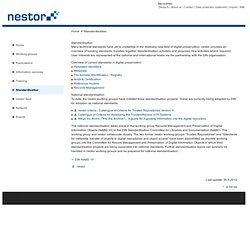
VRA Core 4 Example 26: Landscape painting. Metadata for all: Descriptive standards and metadata sharing across libraries, archives and museums. Integrating digital content from libraries, archives and museums represents a persistent challenge.
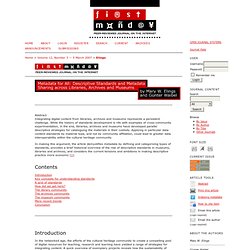
While the history of standards development is rife with examples of cross-community experimentation, in the end, libraries, archives and museums have developed parallel descriptive strategies for cataloguing the materials in their custody. Applying in particular data content standards by material type, and not by community affiliation, could lead to greater data interoperability within the cultural heritage community. In making this argument, the article demystifies metadata by defining and categorizing types of standards, provides a brief historical overview of the rise of descriptive standards in museums, libraries and archives, and considers the current tensions and ambitions in making descriptive practice more economic [1].
Quality Assurance - dollarrpt3.pdf. Technical Guidelines for Digitizing Archival Materials for Electronic Access: Creation of Production Master Files - Raster Images - guidelines.pdf. Art Spaces Archives Project. Interview with Rae Tyson, Artpark Visual Arts Coordinator, 1974-1978. Interviewer: Sandra Q.
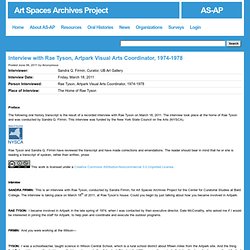
Firmin, Curator, UB Art Gallery Person Interviewed: Rae Tyson, Artpark Visual Arts Coordinator, 1974-1978 Preface The following oral history transcript is the result of a recorded interview with Rae Tyson on March 18, 2011. Rae Tyson and Sandra Q. This work is licensed under a Creative Commons Attribution-Noncommercial 3.0 Unported License. Best Practices for Creating Digital Collections. Technical Guidelines for Digitizing Cultural Heritage Materials - FADGI_Still_Image-Tech_Guidelines_2010-08-24.pdf. Technical Metadata for Digital Still Images - kfile_download. Technical Guidelines for Digitizing Archival Materials for Electronic Access: Creation of Production Master Files - Raster Images - guidelines.pdf. You Say You Want a Resolution: How Much DPI/PPI is Too Much? Migrant Mother” by Dorothea Lange.

Courtesy of the Library of Congress. Preserving digital stuff for the future is a weighty responsibility. With digital photos, for instance, would it be possible someday to generate perfectly sharp high-density, high-resolution photos from blurry or low-resolution digital originals? Probably not but who knows? The technological future is unpredictable. The possibility invites the question: shouldn’t we save our digital photos at the highest resolution possible just in case? Cataloging Hidden Special Collections and Archives. About the Program Libraries, archives, and cultural institutions hold millions of items that have never been adequately described.

This represents a staggering volume of items of potentially substantive intellectual value that are unknown and inaccessible to scholars. This program seeks to address this problem by awarding grants for supporting innovative, efficient description of large volumes of material of high value to scholars. The Council on Library and Information Resources administers this national effort with the generous support of The Andrew W. Mellon Foundation. The primary criterion the review panel uses to evaluate projects is their potential national impact on scholarship and teaching. Metadata Encoding and Transmission Standard (METS) Official Web Site. How to Request a MARC Organization CodeMARC Code List for Organizations (Network Development and MARC Standards Office, Library of Congress)
>> Go to MARC Organization Code Request Form NOW << Before making a request for a new code, search the MARC Organization Code database first to see if a code has already been assigned.
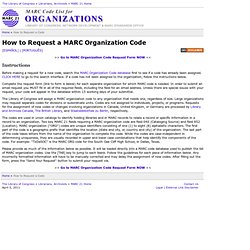
CLICK HERE to go to the search interface. If a code has not been assigned to the organization, follow the instructions below. Complete the request form (link to form is below) for each separate organization for which MARC code is needed. In order to submit an email request you MUST fill in all of the required fields, including the field for an email address. Implementing DACS at Princeton University - SGA11.2007.pdf. Archiveguide.witness.org. Legalities of Nonprofit Internships. Dear Rita: Our nonprofit is getting inquiries from college students asking if we offer summer internships.
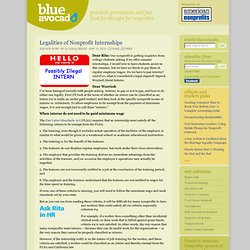
I would love to have students assist us this summer, but we have no funds to pay them at regular employee wages. Do we have to pay interns? Joan Mitchell Foundation » Artist Programs » Creating a Lasting Legacy Program. Creating a Living Legacy (CALL) is a program of the Joan Mitchell Foundation that provides support to visual artists in creating, through organizing and inventorying, comprehensive documentation of their artworks and careers.

In 2007 the Joan Mitchell Foundation began exploring new ways to support mature artists in the thorough documentation and preservation of a their legacy. During the initial pilot phase of CALL, we worked in-depth with four artists in this process: Mildred Howard, Elemore Morgan, Jr., Jaune Quick-To-See Smith, and Freddy Rodriguez. From what was learned during this in-depth work, the Foundation developed a range of tools for artists. The JMF CALL Database was created as a method of keeping accurate records. BostonCollIRAOralHist_FINAL2.pdf.
Major Legal Challenges » Oral History in the Digital Age. By John Neuenschwander In 2007 the California Supreme Court decided the most noteworthy 21st century case involving the legal liability of an oral history archive.[1] While the court’s ruling was favorable, the archival practice that spawned the lawsuit highlights the vast difference between two different information sharing eras.

The allegedly defamatory statements that led to this lawsuit were discovered by a researcher who read an interview transcript that had been available for public inspection for over eight years. Only three other libraries had copies of this transcript and of course the researcher had to physically go to the Regional Oral History Office (ROHO) in the Bancroft Library at the University of California, Berkeley to read it. Tool_archiveformats.pdf. Tool_archivalmaterials.pdf. Artist's Legacy Toolkit. Not everything in your files needs to become part of your archive.
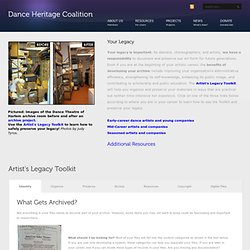
However, some items you may not want to keep could be fascinating and important to researchers. What should I be looking for? Most of your files will fall into the content categories as shown in the tool below. If you are just now developing a system, these categories can help you separate your files. Joan Mitchell Foundation » Artist Programs » Creating a Lasting Legacy Program. Joan Mitchell Foundation » Artist Programs » Creating a Lasting Legacy Program.